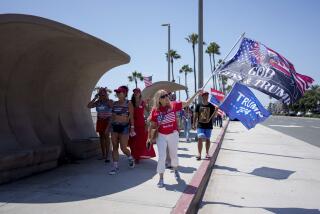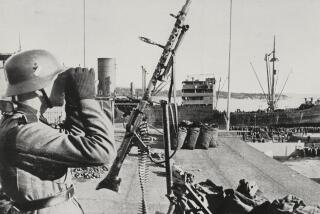Norway Integrating Muslims at Glacial Pace
- Share via
OSLO — On a day when Lena Larsen may slip on a headscarf and walk with humility toward the mosque, her nemesis across town, Shabana Rehman, may strip off her clothes, spray-paint her body and joke about her sex life to a room full of mystified Norwegians.
Both women are Muslim with an edgy sense of humor, but their quests to integrate the Islamic and Norwegian communities are as different as their fashion tastes. Born in Norway and a convert to Islam, Larsen speaks of prayer rituals and the false glamour of sin. Rehman’s native land is Pakistan, and she prefers the straightforward talk of a truck driver to shatter taboos and convince Nordic Christians that -- ski-jumping aside -- Muslims are a lot like them.
“I don’t take off my clothes and paint the Norwegian flag on my body,” Larsen said of Rehman and their public spat over virtue. “I am the antihero because I seem to have given up my ‘Norwegianness’ to become a Muslim, and Shabana was considered a hero because she came closer to Norwegian ideals. The problem is when she is put up as a model for Muslim youth.”
Rehman’s retorts are equally scathing. “Lena suggested my stand-up comedy show is more dangerous to Muslims than the Sept. 11 terrorist attacks. Can you believe that?” she said.
The women exemplify Norway’s frustration at building a multicultural society. Internationally known for promoting peace, this nation of 4.5 million people is struggling to integrate about 70,000 Muslims, including political refugees and economic migrants. Similar problems ripple across Scandinavia, where stereotypes and prejudices in Denmark and Sweden contrast with hallmarks of equality and tolerance.
Religious and cultural tensions were underscored last month when an Al Qaeda lieutenant listed Norway among the group’s top terrorist targets, which also included the U.S. and Britain. Although Norway has troops in Afghanistan and is investigating a mullah with alleged ties to Osama bin Laden, most Norwegians believe that the terrorist threat was a mistake. But it prompted many to reflect on their relations with Muslims.
“We never succeeded at integration,” said Hans Geelmuyden, senior partner in an Oslo management consultant firm. “When you live not far from the North Pole and Santa Claus, it makes you a little naive. We tried to welcome them. We built mosques and hired teachers who spoke Urdu ... but our government policies failed and we created two separate worlds.”
Norway’s reputation for social harmony is not always deserved, said Shoaib Sultan, a member the Islamic Council in Oslo who moved here from Pakistan when he was a child. “Muslims here do see problems,” he said. “An imam is supposed to go out and condemn the Al Qaeda threats, but at the same time he is not believed. Nothing we ever do is good enough. I think now it’s more politically acceptable to speak out against Muslims.”
Away from the harbor, the sidewalks change under the overpass and into the Gronland neighborhood. Cultures here have not integrated but their divergent images commingle. There are headscarves and saris; the scents of cumin and mangoes. African Muslims wearing prayer caps walk beneath the steeple of a Protestant church. Hassan’s Import/Exports sits across from a bingo parlor. And a Pakistani girl skips past a cartoon poster of two Norwegian women having sex.
Around the corner, Tommy Merg sits on a bench in the sun, smoking a cigarette and remembering the days when he played guitar in one of Norway’s first rhythm-and-blues bands -- the Sapphires. It was 1965, and a guy from New York City nicknamed “Little Earl” showed up in Oslo with a box of James Brown records. Little Earl was lead vocal, said Merg, and no one seemed to mind that he was black. He fit in; he integrated.
The North Sea oil boom came and the band split. Little Earl opened a coffee shop. Merg became a social worker in Gronland, where a lot of his clients are immigrant Muslims. They haven’t integrated, said Merg, adding that, “I’ve never seen a Muslim on skis. OK, maybe one. I organized school bands for eight years [but] I’ve only had a total of four Muslims play for me. I don’t think the problem of integration is skin color. It’s religion.”
It is often on the religious plane where the two societies part. In a country where nudity is common on beaches and in saunas, Muslim families have requested that their children not shower with others after gym classes and that their daughters have separate swimming lessons so as not to share the pool with boys. Muslims contend that such measures allow them to adhere to the Koran’s teachings on humility; many Norwegians view them as signs of isolation.
Romance, too, is seldom a cross-cultural affair: Between 1996 and 2000, according to the Norwegian Foreign Ministry, only three of 682 Pakistani women married Norwegian men.
The first wave of Muslim immigrants arrived in Norway in the late 1960s. They worked in mills and ship factories and sent money home to their families. By the mid-1970s, Norway closed its borders to economic migrants, but allowed those working in the country to resettle their families. Asylum-seekers from Bosnia-Herzegovina and Kosovo arrived in the 1990s. Today, six out of Norway’s 10 most populous immigrant groups come from Muslim countries or regions.
The country’s largest immigrant group is Pakistani, with a population of more than 25,500. A 2002 survey conducted by Norway’s statistics agency found discrepancies in attitudes toward immigrants. More than two-thirds of Norwegians agree that immigrants enrich work life and culture. But 40% said foreigners “represent a source of insecurity in society,” according to the poll, which also suggested that those who prefer “stricter rules” for accepting refugees increased by 20% since 2000.
Much of the anxiety over immigration emanates from the terrorist attacks that have roiled the world since Sept. 11, 2001. Norway is not considered a haven for militants, but Oslo is holding Mullah Krekar, who is alleged to have links to Al Qaeda. A founder of the radical Ansar al Islam group in northern Iraq, Krekar, who has refugee status in Norway, is under investigation in Norwegian courts for terrorist-related activities. He has denied the charges.
When Shabana Rehman appears on stage, she is veiled in a black burka with only her eyes revealed. She steps to a microphone and, in an instant, the audience realizes this is not a Muslim woman normally encountered along the fjords. That is Rehman’s intent. The only things sacred in her act are one-liners; she lampoons religion, tradition, sex and idiosyncrasies, such as a penchant for precision, that make Norwegians “utterly exotic” to Muslims.
One such joke is about suicide bombers rewarded with 72 virgins. “What about female suicide bombers?” she says. “What will be their reward? Seventy-two untouched men? That is not so nice.”
The daughter of a restaurant owner, Rehman was born in Karachi, Pakistan, and came to Norway when she was a year old. She said she has been disturbed in recent years by the stereotypical portrayals of immigrants in the Norwegian media. Her satire is also aimed at the Muslim community, which she blames for streaks of fundamentalism and the inability to discuss democracy and the modern world.
“I’m challenging Norwegians and Muslims,” said Rehman, who also writes a newspaper column. “I want them to see that we each have an identity and can live in a multicultural Norway.” A place where, she quips, Muslim women can “walk around like wandering tents” while Norwegian women “have to go for lipo-sculpturing.”
Lena Larsen is not amused. She doesn’t believe wisecracks are the solution to what she considers discrimination against Muslims. To buttress her point, she said, Rehman’s success is based on the premise that “for a Muslim woman to be heard, she must be anti-Muslim.”
“Islam is being distorted in Norway,” she added. “It’s viewed as backward and oppressive to women. Many old Norwegians are supportive of Israel and have doubts about Islam and Muslims. Our imams are not respected. They are considered to have two faces.”
An Arabic language major, Larsen converted to Islam in 1983 after visiting Morocco, where she glimpsed a woman praying in her home. “It was natural and pure,” she said. Today, she has a Muslim husband and wears a headscarf and jokes that she’s something of a rebel because religious conservatives complain when she wears pants.
“I’m trying to bridge two worlds too,” said Larsen, the former president of the Islamic Council, which is lobbying for a university education program to train mullahs in Oslo. “We have to change things because Muslims in the public sphere are losing one battle after another.”
Outside the prayer room in the mosque, Larsen’s fair skin and beige headscarf are a contrast to those with darker complexions prostrating in prayer.
“Muslims are not against equality,” she said. “We live in the same society, but sometimes there are differences that must be respected.”
More to Read
Sign up for Essential California
The most important California stories and recommendations in your inbox every morning.
You may occasionally receive promotional content from the Los Angeles Times.











